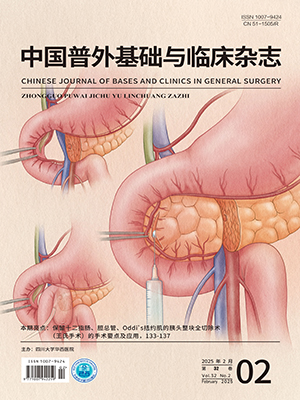| 1. |
Bray F, Ferlay J, Soerjomataram I, et al. Global cancer statistics 2018: GLOBOCAN estimates of incidence and mortality worldwide for 36 cancers in 185 countries. CA Cancer J Clin, 2018, 68(6): 394-424.
|
| 2. |
Chen W, Sun K, Zheng R, et al. Cancer incidence and mortality in China, 2014. Chin J Cancer Res, 2018, 30(1): 1-12.
|
| 3. |
Torre LA, Bray F, Siegel RL, et al. Global cancer statistics, 2012. CA Cancer J Clin, 2015, 65(2): 87-108.
|
| 4. |
Anguille S, Smits EL, Lion E, et al. Clinical use of dendritic cells for cancer therapy. Lancet Oncol, 2014, 15(7): e257-e267.
|
| 5. |
Ilett EJ, Prestwich RJ, Melcher AA. The evolving role of dendritic cells in cancer therapy. Expert Opin Biol Ther, 2010, 10(3): 369-379.
|
| 6. |
Jäkel CE, Vogt A, Gonzalez-Carmona MA, et al. Clinical studies applying cytokine-induced killer cells for the treatment of gastrointestinal tumors. J Immunol Res, 2014, 2014: 897214.
|
| 7. |
Gungor-Ordueri NE, Tang EI, Celik-Ozenci C, et al. Ezrin is an actin binding protein that regulates sertoli cell and spermatid adhesion during spermatogenesis. Endocrinology, 2014, 155(10): 3981-3995.
|
| 8. |
Di L, Zhu Y, Jia J, et al. Clinical safety of induced CTL infusion through recombinant adeno-associated virus-transfected dendritic cell vaccination in Chinese cancer patients. Clin Transl Oncol, 2012, 14(9): 675-681.
|
| 9. |
Montagna D, Turin I, Schiavo R, et al. Feasibility and safety of adoptive immunotherapy with ex vivo-generated autologous, cytotoxic T lymphocytes in patients with solid tumor. Cytotherapy, 2012, 14(1): 80-90.
|
| 10. |
Amin MB, Edge SB, Greene FL, et al. AJCC Cancer Staging Manual. 8th ed. NewYork: Springer, 2017.
|
| 11. |
中华人民共和国卫生部医政司. 胃癌诊疗规范(2011 年版). 中国医学前沿杂志(电子版), 2012, 4(5): 62-71.
|
| 12. |
高作文, 郑劼, 娄金书, 等. DC-CIK 细胞免疫治疗胃癌的临床疗效及预后分析. 中国肿瘤生物治疗杂志, 2017, 24(2): 174-179.
|
| 13. |
万崇华, 陈明清, 张灿珍, 等. 癌症患者生命质量测定量表EORTC QLQ-C30中文版评介. 实用肿瘤杂志, 2005, 20(4): 353-355.
|
| 14. |
杨林, 刘静维, 张雯, 等. DC-CIK 细胞联合化疗治疗局部晚期不可切除或转移性胃腺癌的临床疗效. 中国肿瘤生物治疗杂志, 2017, 24(9): 966-971.
|
| 15. |
Couzin-Frankel J. Breakthrough of the year 2013. Cancer immunotherapy. Science, 2013, 342(6165): 1432-1433.
|
| 16. |
Galluzzi L, Senovilla L, Vacchelli E, et al. Trial watch: Dendritic cell-based interventions for cancer therapy. Oncoimmunology, 2012, 1(7): 1111-1134.
|
| 17. |
Verma V, Kim Y, Lee MC, et al. Activated dendritic cells delivered in tissue compatible biomatrices induce in-situ anti-tumor CTL responses leading to tumor regression. Oncotarget, 2016, 7(26): 39894-39906.
|
| 18. |
吴凤丽, 李国华. 树突状细胞疫苗在胃癌免疫治疗中的研究进展. 世界华人消化杂志, 2014, 22(1): 46-52.
|
| 19. |
Thanendrarajan S, Nowak M, Abken H, et al. Combining cytokine-induced killer cells with vaccination in cancer immunotherapy: more than one plus one? Leuk Res, 2011, 35(9): 1136-1142.
|
| 20. |
龚福生, 陈路川, 杨建伟, 等. 自体肿瘤抗原负载 DC-CIK 细胞治疗胃癌的疗效分析. 中国肿瘤生物治疗杂志, 2016, 23(6): 813-818.
|
| 21. |
刘小军, 侯小明, 张健, 等. 自体 DC-CIK 细胞联合化疗治疗晚期胃癌的回顾性研究. 中国肿瘤生物治疗杂志, 2016, 23(6): 819-823.
|
| 22. |
刘清池, 张慧敏, 张玉娜, 等. DC-CIK 细胞清除微小残留白血病的临床研究. 中国肿瘤生物治疗杂志, 2013, 20(4): 398-403.
|
| 23. |
Lee JH, Lee JH, Lim YS, et al. Adjuvant immunotherapy with autologous cytokine-induced killer cells for hepatocellular carcinoma. Gastroenterology, 2015, 148(7): 1383-1391.
|
| 24. |
Liu L, Zhang W, Qi X, et al. Randomized study of autologous cytokine-induced killer cell immunotherapy in metastatic renal carcinoma. Clin Cancer Res, 2012, 18(6): 1751-1759.
|
| 25. |
Pan K, Guan XX, Li YQ, et al. Clinical activity of adjuvant cytokine-induced killer cell immunotherapy in patients with post-mastectomy triple-negative breast cancer. Clin Cancer Res, 2014, 20(11): 3003-3011.
|
| 26. |
Leemhuis T, Wells S, Scheffold C, et al. A phase Ⅰ trial of autologous cytokine-induced killer cells for the treatment of relapsed Hodgkin disease and non-Hodgkin lymphoma. Biol Blood Marrow Transplant, 2005, 11(3): 181-187.
|




